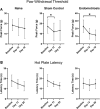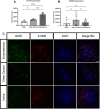Implication of the enteric glia in the IBS-like colonic inflammation associated with endometriosis
- PMID: 39707348
- PMCID: PMC11662455
- DOI: 10.1186/s12905-024-03480-7
Implication of the enteric glia in the IBS-like colonic inflammation associated with endometriosis
Abstract
Background: Endometriosis is a complex gynecological disorder characterized by the ectopic growth of endometrial tissue. Symptoms of endometriosis are known to impair the quality of life of patients, and among these are found dysmenorrhea, chronic pelvic pain, and gastrointestinal (GI) issues. GI issues such as painful bowel movements, bloating and constipation or diarrhea, are one of the common reasons for misdiagnosis with irritable bowel syndrome (IBS). Enteric glial cells (EGC) are known to play a role in pain associated with IBS, and reactive gliosis has been reported in patients with IBS, but the role of EGC in endometriosis has yet to be elucidated. We hypothesized that endometriosis will induce reactive gliosis, with increased expression of the glial fibrillary acidic protein (GFAP) and S100B, in the myenteric plexus of colonic sections in an animal model of endometriosis.
Methods: In the present study animal experiments were employed to explore the impact of endometriosis on the gastrointestinal tract. Using a surgically induced endometriosis rat model, we collected ileal and colonic segments for analysis. We used H&E to assess microscopic damage in colon and ileum, immunofluorescence to measure GFAP and S100B expression in the colon, and toluidine blue staining to measure mast cell infiltration in colon and ileum. Immunofluorescence images were captured using confocal microscope and analyzed using ImageJ software.
Results: All endometriosis animals developed vesicles. These animals had a significant increase in the colonic macroscopic damage compared to Sham and Naïve controls. Colonic and ileal sections didn't show statistical differences in microscopic damage between groups, yet endometriosis ileum had significantly increased mast cell infiltration compared to Naïve. GFAP immunostaining showed significantly increased integrated density in endometriosis when compared to Sham or Naïve, while no statistical difference was found in S100B integrated density between groups.
Conclusions: We conclude that endometriosis can alter GI homeostasis by inducing colon inflammation, reactive gliosis, and ileal mast cell infiltration. Taken together this suggests endometriosis can mimic IBS histopathology beyond the symptomatology, reinforcing this disease's complexity and the need to treat it beyond the gynecological setting.
Keywords: Colon; Endometriosis; Enteric glia; Inflammation.
© 2024. The Author(s).
Conflict of interest statement
Declarations. Ethics approval and consent to participate: All research involving animals was approved by the Institutional Animal Care and Use Committee at Ponce Health Sciences University. Consent to participate declaration: not applicable. Consent for publication: Not applicable. Competing interests: The authors declare no competing interests.
Figures






References
-
- De Graaff A, D’Hooghe T, Dunselman G, Dirksen C, Hummelshoj L, Simoens S, Bokor A, Brandes I, Brodszky V, Canis M, Colombo G, DeLeire T, Falcone T, Graham B, Halis G, Horne A, Kanj O, Kjer J, Kristensen J, Wullschlege M. The significant effect of endometriosis on physical, mental and social wellbeing: results from an international cross-sectional survey. Hum Reprod. 2013;28(10):2677–85. 10.1093/humrep/det284. - PubMed
-
- Maroun P, Cooper MC, Reid GD, Keirse MJNC. Relevance of gastrointestinal symptoms in endometriosis. Aust N Z J Obstet Gynaecol. 2009;49(4):411–4. 10.1111/j.1479-828x.2009.01030.x. - PubMed
MeSH terms
Substances
Grants and funding
LinkOut - more resources
Full Text Sources
Medical
Miscellaneous

